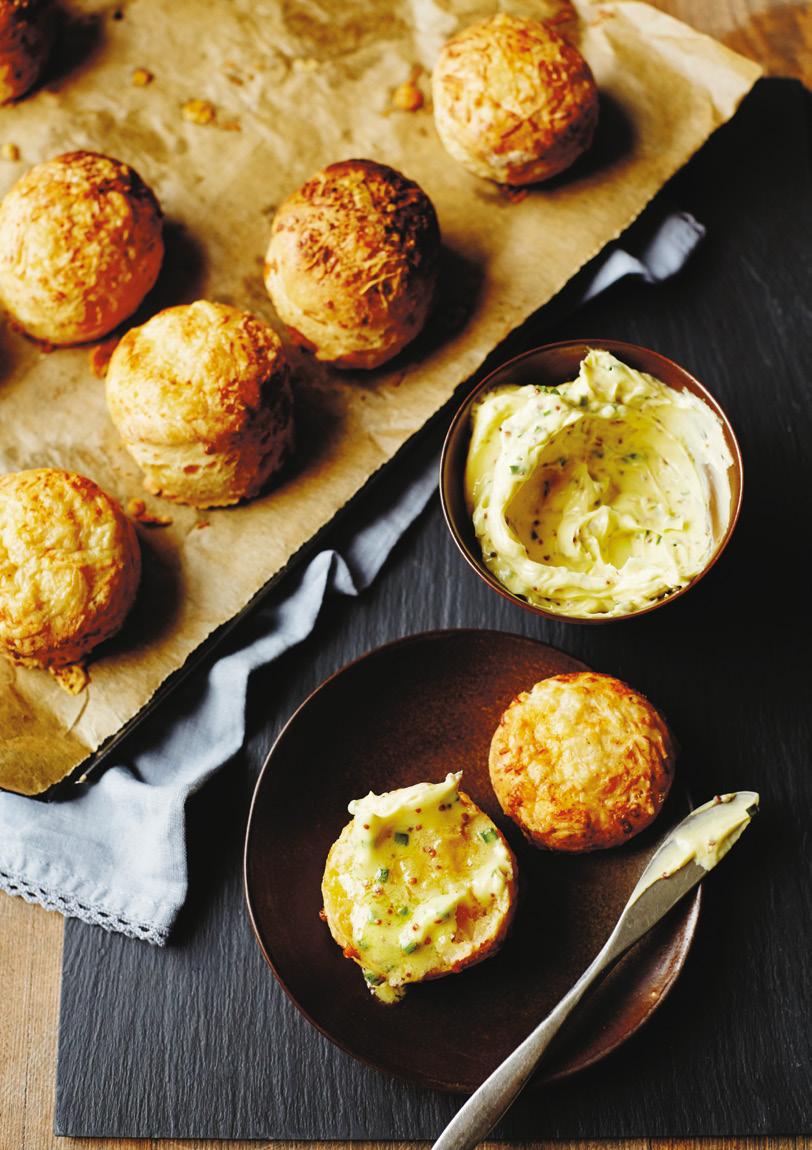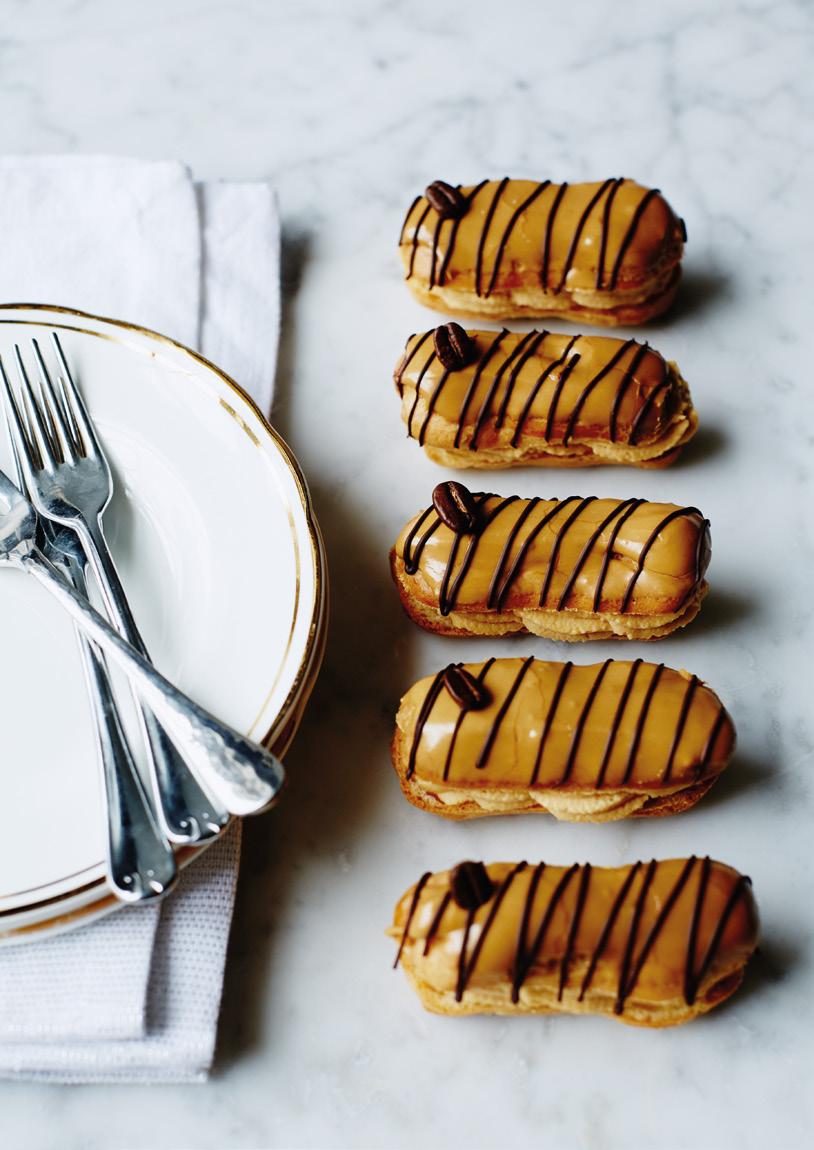
9 minute read
TIME FOR TEA
by Dales Life
Stunning recipes for the ultimate afternoon tea, from master patissier Will Torrent
BLOODY MARY SHRIMP SANDWICH The crushed avocado butter elevates it even further
Advertisement

BEETROOT CURED SALMON WITH HORSERADISH CRÈME FRAÎCHE Curing your own salmon really isn’t as difficult as it sounds

TRIPLE CHEESE SCONES WITH WHIPPED MUSTARD BUTTER Served with whipped mustard butter they are just gorgeous

COFFEE AND CARAMEL ÉCLAIRS There is something elegant and sophisticated about little pastries
The addition of some of the ingredients that make up a Bloody Mary cocktail to a classic Marie Rose sauce takes a simple prawn/shrimp sandwich to a whole new level. The crushed avocado butter elevates it even further, which in my opinion, when done right, is simply stunning.
8MAKES
400g cooked north Atlantic prawns/ shrimp 3 tablespoons mayonnaise 1 tablespoon ketchup 1⁄2 teaspoon paprika a splash of Tabasco 1 tablespoon vodka (optional) a dash of Worcestershire sauce salt and freshly ground black pepper, to taste
AVOCADO BUTTER 75g butter, softened 1 ripe avocado juice of 1⁄2 lemon salt and freshly ground black pepper, to taste
TO SERVE 8 thin slices brown bread 2 heads Little Gem lettuce, shredded celery salt, to taste
METHOD
Pat the prawns/shrimp dry with paper towels and tip into a bowl. Add the mayonnaise, ketchup, paprika, Tabasco, vodka (if using) and a shake of Worcestershire sauce. Season with salt and black pepper, and mix well to coat the prawns/shrimp. Taste and add a drop more Tabasco if you prefer the Bloody Mary sauce a little spicier.
In another bowl, beat the butter until soft. Peel and mash the avocado flesh, and add to the butter with the lemon juice. Season with salt and black pepper to taste.
Lay the bread slices out on the work surface and spread with the avocado butter. Cover half of the slices with the prawn/shrimp mixture and top with a neat handful of shredded lettuce. Cover with the remaining bread slices and press gently together.
Using a serrated bread knife, cut the sandwiches in half or into neat triangles or fingers. Arrange on serving plates and sprinkle with a little celery salt before serving.
Recipes are taken from 'Afternoon Tea at Home' by Will Torrent with photography by Matt Russell, Ryland Peters & Small, £19.99.
BEETROOT CURED SALMON with horseradish crème fraîche on rye bread
Curing your own salmon for a celebration really isn’t as difficult as it may sound! It gives you such satisfaction when it is done and tastes amazing. The colour of the beetroot doesn’t quite seep into the centre of the salmon giving you such a lovely colour contrast.
18-20 MAKES
a 500g piece of salmon, pin-boned and scaled (skin on) 1 tablespoon grated fresh or preserved horseradish 175g crème fraîche 6–8 thin slices rye bread 50g butter salt and freshly ground black pepper, to taste fresh dill or watercress, to garnish BEETROOT CURE 2 raw beetroot (about 200g) 1 teaspoon pink peppercorns 1 teaspoon fennel seeds 1 teaspoon juniper berries 60g coarse sea salt 50g golden caster sugar zest of 1 lemon zest of 1⁄2 orange 2–3 tablespoons freshly chopped dill 3 tablespoons vodka
a baking sheet lined with three layers of clingfilm
METHOD
First, prepare the beetroot/beet cure. Peel and coarsely grate the beetroot into a large mixing bowl. Lightly crush the peppercorns, fennel seeds and juniper berries using a pestle and mortar, applying just enough pressure to release their flavours. Add them to the bowl with the salt, sugar, lemon and orange zests and half of the chopped dill. Mix to combine.
Scatter one-third of the beetroot cure over the prepared baking sheet and lay the salmon on top, skin-side down. Cover the salmon with the remaining cure, pressing it into an even layer over the fish. Slowly spoon the vodka over the top and wrap the salmon tightly in the excess clingfilm. Lay another tray or tin on top of the salmon and weigh it down with something heavy. Set in the fridge for at least 2 days to cure.
Take the salmon from the fridge and unwrap it over a sink to catch the purple juices. Using your hands, scrape off as much of the beetroot/beet cure as possible and pat the fish dry with paper towels. Finely chop the remaining dill and press into the top (flesh side) of the salmon. Using a very sharp knife cut the salmon into wafer thin slices – cutting down to, but not through the skin so you can transfer it easily to a serving platter.
Mix the grated horseradish with the crème fraîche and salt and black pepper. Thinly spread the rye bread slices with butter and cut into bite-sized pieces. Spread with the horseradish crème fraîche and lay the salmon slices on top. Garnish with a little fresh dill or watercress and a twist of freshly ground black pepper. Caper berries work exceptionally well with this tartine, too.
TRIPLE CHEESE SCONES with whipped mustard butter
Another of my Nan’s favourite recipes was her cheese scones, fresh out of the oven and spread with butter that melted instantly. In my version I’ve added three different cheeses; Cheddar, Gruyère and Parmesan, for a really cheesy taste. Served with a whipped mustard butter they are just gorgeous. Some crispy pancetta sprinkled on top would be very tasty, too.
16 MAKES
350g plain flour 100g spelt flour 3 teaspoons baking powder 1⁄2 rounded teaspoon
English mustard powder 1⁄4–1⁄2 teaspoon cayenne pepper 75g butter, chilled and diced 50g coarsely grated Cheddar, plus extra for the topping 50g coarsely grated Gruyère 25g finely grated Parmesan, plus extra for the topping 125ml buttermilk 150ml whole milk, plus 1 tablespoon for glazing salt and freshly ground black pepper, to taste
MUSTARD BUTTER 125g butter, softened 1 teaspoon English mustard 1 teaspoon grainy mustard 2 teaspoons finely chopped fresh chives
a 5-cm round cookie cutter a baking sheet lined with baking parchment
METHOD
First make the mustard butter. Beat the butter with a wooden spoon until really light and creamy. Add both types of mustard and season with salt and black pepper. Mix to combine, then add the chopped chives. Lay a sheet of clingfilm or baking parchment on the work surface and lay the butter on top in a rough sausage shape. Roll the butter into a neat log roughly 2cm in diameter. Twist the ends to seal and chill the butter for about 2 hours until firm.
Preheat the oven to 200°C/fan 180°C/gas 6.
Sift the plain flour, spelt flour, baking powder, mustard powder and cayenne pepper into a large mixing bowl. Season well with black pepper and a pinch of salt. Add the chilled, diced butter and rub into the dry ingredients using your fingertips. When there are only very small specks of butter still visible add the grated Cheddar, Gruyère and Parmesan cheeses and mix to combine.
Make a well in the middle of the mixture and pour in the buttermilk and milk. Use a palette knife to mix into a dough, then very lightly bring the mixture together with your hands to a rough ball.
Turn the dough out onto a lightly floured surface and knead for 10 seconds. Flatten or roll out to a thickness of 1.5–2cm. Use the cookie cutter to stamp out rounds and arrange on the prepared baking sheet, leaving a little space between each scone to allow for spreading during baking. Gather the dough scraps into a ball, re-roll and stamp out more scones. Brush the top of the scones with a little milk, scatter with the extra cheeses and a pinch of cayenne pepper.
Bake on the middle shelf of the preheated oven for about 13–15 minutes until well-risen and golden brown. Cool on a wire rack.
Split the scones in half and spread with the mustard butter to serve.
There is something so elegant and sophisticated about little pastries, as epitomised by these caramel-cream-filled, coffee-iced éclairs! The flavours work well together as the caramel balances out the intensity of the coffee.
METHOD
30 MAKES
75ml whole milk 60g butter, diced a pinch of salt a pinch of sugar 100g plain flour, sifted 3 eggs, lightly beaten CARAMEL 150g caster sugar 100ml whipping cream 4 cardamom pods 25g unsalted butter a pinch of sea salt flakes TO DECORATE 225g fondant icing sugar 2 teaspoons instant coffee granules 75g chopped dark chocolate, melted coffee beans (optional)
a large baking sheet lined with baking parchment 2 disposable piping bags a piping bag fitted with a star nozzle
Preheat the oven to 180°C/fan 160°C/gas 4. Put 75ml of water in a medium saucepan with the milk and butter and set over a medium heat. Stir constantly to melt the butter. As soon as the mixture comes to the boil, reduce the heat slightly and, working quickly, keeping the pan over a low heat, stir in the flour and season well with salt and black pepper. Beat vigorously until smooth and the mixture cleanly leaves the sides of the pan – this will take about 2 minutes. Transfer the dough to a stand mixer or mixing bowl (using a handheld electric whisk) and gradually beat in the eggs 1 tablespoon at a time. You might not need all of the egg – when the dough is soft and smooth and drops off a spoon leaving a ‘V’ shape behind it is ready. Scoop the dough into the piping bag and pipe 30 éclairs onto the prepared baking sheets leaving plenty of space between each one. Bake on the middle shelves of the preheated oven for 10–15 minutes until well-risen, golden brown and sound hollow in the middle when tapped. Remove from the oven and make a small hole in the side of each bun with a skewer and return to the oven for a further 1 minute to dry out the insides. Leave to cool on a wire rack until cold. To make the caramel, tip the sugar into a medium saucepan. Add 1 tablespoon of water and set the pan over a low–medium heat to dissolve the sugar, without stirring. Continue to cook the syrup until it becomes an amber-coloured caramel, swirling the pan to ensure the caramel cooks evenly. Meanwhile, heat 100ml of the cream until it just boils either in a heatproof jug in the microwave or in a small saucepan. Working quickly, slide the caramel off the heat and carefully add the hot cream (the caramel will hiss and bubble). Add the butter and salt, and stir until smooth. Return the pan to a low heat, simmer for 30 seconds, then strain. Next, prepare the fondant glaze for decoration. Sift the fondant icing sugar into a bowl. In another small bowl dissolve the coffee granules in 2 teaspoons of boiling water. Add the coffee to the sugar and, whisking constantly, add enough cold water to make a soft, smooth spreadable glaze. Cover and set aside. When you are ready to fill the éclairs, whip the remaining cream until it will hold a soft peak. Fold 2–3 tablespoons of cream into the reserved caramel to lighten it and then carefully fold in the rest. Spoon into the piping bag. Cut each éclair in half and pipe the caramel cream into the bottom half, then cover with the lid. Using a teaspoon or small off-set palette knife, spread the fondant glaze neatly over the top of each éclair and leave for about 30 minutes to set.
Drizzle melted chocolate over each éclair, decorate with a coffee bean and serve.










